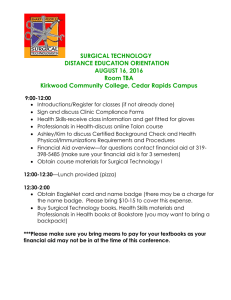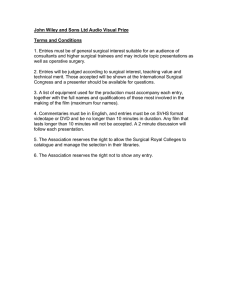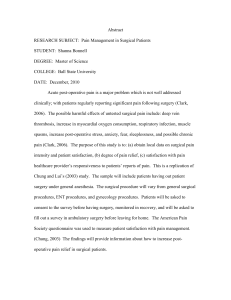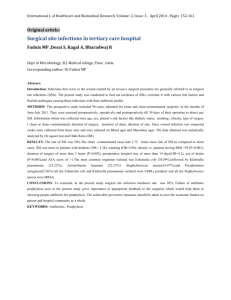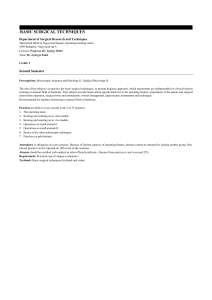Surgical Site Infection Reduction Project: Haramaya Hospital
advertisement
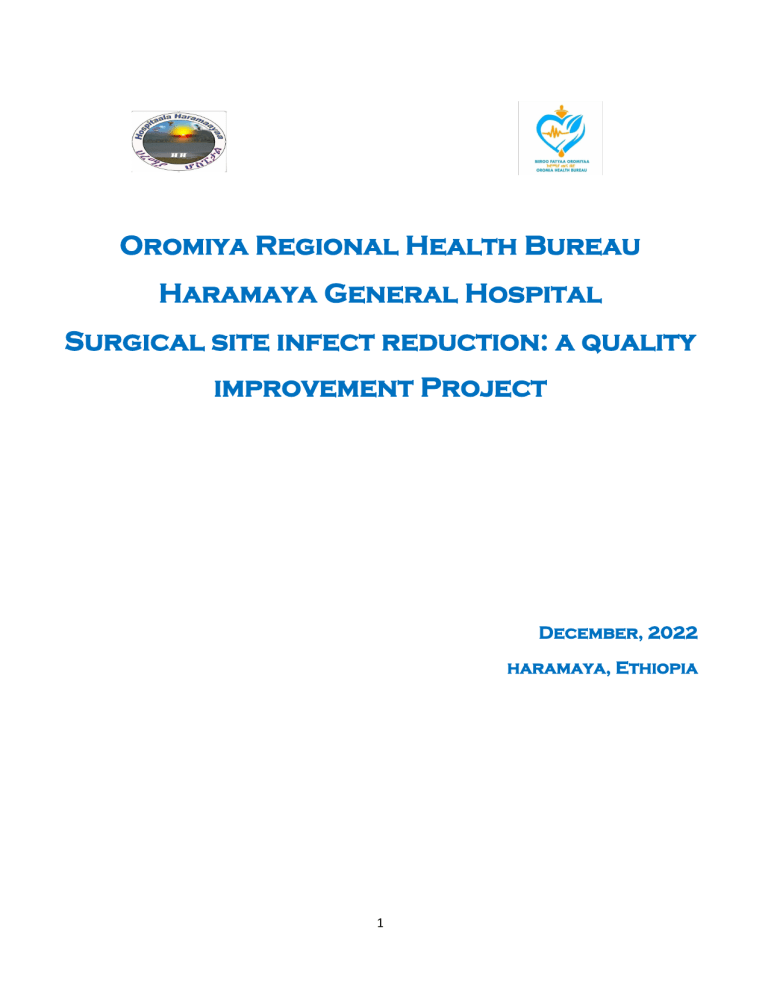
Oromiya Regional Health Bureau Haramaya General Hospital Surgical site infect reduction: a quality improvement Project December, 2022 haramaya, Ethiopia 1 QI members Dr Badhaasaa Beyene – Project leader and PI Dr Basit Abrahim- Co-Investigator Dr Solomon Tamirat – member Mr Ahmed Abulselam (CEO) – member Sr Woinishet - member (supervisor at OR) Sr Muntaha Abdi - member Mr Harif A–Member Mr Habtamu G– member Mr Ershad A - member 2 Abstract Background Surgical site infection is an old and ever-changing surgical problem that needs attention to decrease its magnitude. Improvement in quality of service has shown effective in reducing the prevalence of surgical site infection in developed countries using evidence-based strategies. This evidence-based finding was introduced to health workers and staffs of Haramaya General Hospital working at surgical ward and Operation Theatre. Method The quality improvement project is a routine activity evaluation at our hospital for the proper use of resources based on evidence-based care (EBC). The project was designed as an observational follow up for operated patient in our hospital from August 1 – December 31st, 2022. Problem identification was done through brainstorming using driver diagram model and intervention introduced from Evidence Based findings for health workers as fresher training. Continuous supervision was made for data collectors and evaluation has been conducted every month. Result Two hundred seventy-six patients were followed over the project period. Surgical site infection was developed in 8.3 %% of patients on average. The overall death rate during follow up period was 5 (1.8%) from which 4 (80%) were directly or indirectly associated with surgical site infection. Length of hospital stay was significantly higher in patients who have developed surgical site infection; 19.6 + 11 days compared to 5.85 + 3 days in those surgical site infections didn’t develop. Conclusion and recommendations The rate of surgical site infection was significantly reduced following the introduction of EBC compared to the pre-intervention period. The use of WHO surgical safety checklist usage has almost become complete but more stress has to be made on the components, especially at the sign out period. The infrastructure improvement and supplies weren’t optimal which need higher governmental intervention and allocation of adequate budget. The hospital has to device a mechanism to trace and follow a loss to follow up of postoperative patients to make sure surgical site infection occurrence. Key words: SSI; EBC; superficial surgical site infection; 3 Introduction Surgical site infections (SSIs) are defined as infections occurring up to 30 days after surgery or up to one year after surgery in patients receiving implants[1, 2]. SSIs are classified into incisional [sub classified into superficial (limited to skin and subcutaneous tissue) and deep incisional] and organ/space infections. The development of SSIs is affected by the degree of microbial contamination of the wound during surgery, the duration of the procedure and host factors such as diabetes, malnutrition, obesity, immune suppression and a number of other underlying disease states[3]. About 80% to 90% of all postoperative infections occur within 30 days after the operative procedure. Most of the wound infection manifest within a week of surgery[2]. Surgical site infections are main part of Nosocomial infections [4]. Despite the advances made in asepsis, antimicrobial drugs, sterilization and operative techniques, and availability of antimicrobial prophylaxis, SSIs remain a substantial cause of morbidity, prolonged hospitalization and death[4, 5]. The incidence of SSIs may be as high as 20%, depending on the surgical procedure, the surveillance criteria used, and the quality of data collection[6]. SSI is associated with a mortality rate of 3%, and 75% of SSIassociated deaths are directly attributable to the SSI. SSI is the most costly HAI type with an estimated annual cost of $3.3 billion, and is associated with nearly 1 million additional inpatient-days annually[5]. Aim of the project ▪ To decrease the rate of surgical site infection from base line of 13.8% by 50% at December 31, 2022. 4 Rationale Surgical site infection is one of the most common complications in surgical patients reaching up to 36%[7] in some hospitals not only in studies done in Ethiopia but also in other developing countries compared to less than 5% in developed countries. There is no published research concerning the prevalence of the problem in our setup but from a pilot test taken from our hospital before intervention was13.8 %. The infrastructural and hospital set ups , the number of patients admitted in single room, huge number of attendants for single patient under care even during wound might contribute for this raised figure in this set up. Note: • Up to 60% of SSIs have been estimated to be preventable by using evidence-based guidelines. • SSIs account for 20% of all HAIs in hospitalized patients. • Each SSI is associated with approximately 7–11 additional postoperative hospital-days. • Seventy-seven percent (77%) of deaths in patients with SSI are directly attributable to SSI[9]. 3. Problem description and analysis A driver diagram was used to clarify the existing problem and analysis of the problem was made using analysis check list geared to pin point the root cause of the problem and thereby giving the possible solution. The experience from developed countries shows quality improvement in surgical site infection during the last one decade has good change according to different literatures [10]. WHO has developed a world class guideline but it is not being used properly. As WHO report of 2018, surgical site infection is one of the three most causes of morbidity and mortality in surgical patients despite improvement in knowledge in that area and quality of care as well patient awareness concerning surgical site infection. It occurs in 2%–5% of patients undergoing inpatient surgery. Approximately 160,000–300,000 SSIs occur each year in the United States which associated with approximately 7–11 additional postoperative hospital-days. These Patients have a 2–11 times higher risk of death compared with operative patients without SSI[11]. 5 Primary drivers Secondary drivers Change Ideas albumin >3.5 decrease wt for morbid obesity Malnutrition electrolyte and fluid balance Age factor Patient factor judicious fluid adm. CD4 rise >200 control DM Immunesuppre sion chemotherapy after immune reconstituted radiotherapay after 2 weeks of surgery Health worker factor Surgical site Infection Technical facor gentle tissue handling proper stitch material use Behavioural room temp 2025 c OR temperature set up factor OR from up down ventilation OR structure being compliant to SOP water proof and easly cleanable Follow OR SOP aseptic technique WHO guideline Non adherence to SOP prophylactic antibiotic specific case related perioperative care decrease excess talk OR traffic limit number of theatre prepation attends. Figure 1. Driver diagram model for problem identification and possible solutions (Developed from different literatures mentioned in the introduction) Methods 6 The QI Project specifically surgical site infection improvement projected has started from August 1st – December 31st, 2022 in our hospital with more focus areas being surgical ward and Operation theatre. The scope of projected was planned to include all patients operated as emergency and elective base in Haramaya General Hospital during hospital stay until one month post discharge. Due to loss from follow up which reach 75%, the post discharge follow up was dropped. Using PDSA cycle, the underlying problems were assessed with the QI team. At the start of the project base line infrastructural improvement was forwarded to the administration including the request for purchasing basic surgical ward and operation theatre materials. According to problems with initial PDSA, interventional measures were introduced on Health workers and supportive staffs how to improve their daily activities which was training designed on SSI reduction. Data were collected using a checklist attached with patient chart. There after repeated meetings were conducted and successive evaluation and modifications made using PDSA cycle. Measurements The outcome measurement was the magnitude of surgical site infection after introduction of the quality intervention while the process measure was the improvement in proper wound management, adherence to sterile techniques in the OR and proper use of attire in the OR. Interventions planned and forwarded 1. Infrastructure improvement (Forwarded to the administration and respective stakeholders) 1.1.Emergency OPD level a. Adequate EOPD space to accommodate moderate to high patient load and able to manage disaster/causality safely. b. Install separate procedure room and dressing room c. Decrease patient EOPD stay to 24 hours which can be done by another QI team. • Installing radiant heater or AC and insulation of the windows of the OR was recommended as hypothermia is one of the major risk factor behind patient complication following surgery. • Prepare sterile material storage locker/ sealed shelf. • Make ready staff wear to be cleaned and kept in common shelf where the responsible person will take care of it. • Minimize OR traffic • Prepare white board for procedure, instruments and materials announcement. 7 1.2.Surgical ward General improvement: Suggestion on availing standard patient beds, bed pans, general and clinical dirty bin, insulated doors and windows, stretchers for patient transportations. Make ready disinfectants for staff hand rub or tap water with soap. To have all time available oxygen with cylinder or concentrator Supply continuous consumables materials (disinfectants, safety box, bed sheet, blanket, etc.), staff safety wears, and materials for wound care To avail shower facility for admitted patients that will have impact on patient outcome. 2. Practice improvement EOPD Increase the alertness to accept and manage emergency patients Decrease patient stay to 24hrs at emergency Practice proper wound dressing at separate room. Ward ✓ Accept emergency patients preoperatively and prepare for further management; specially give prophylaxis antibiotics as it can be forgotten during emergency procedure in the OR. ✓ Practice proper nursing care starting from patient acceptance to discharge like, proper vital sign monitoring, medication administration, chart keeping, bed making and proper wound care etc.) ✓ Avoid spectators during wound care and generally keep to one or less attendant per patient. ✓ Full time guard has to be at the get of the wards restricting and monitoring the traffic. ✓ To give continuous health education for patients and attendants while in patient or outpatient 2.3 Operation Theatre 2.4.1 Cleaning practice, ✓ Use of proper proportion of water and chemicals, techniques of cleaning. ✓ OR fumigation routinely (at least once monthly) 2.4.2 Material handling, sterilization and storage practice: ✓ Gown, drapes, and gauze/packs – starting from washing to sterilization strict clear standard or operating procedure has to be followed ✓ Sterility indicators have to always be used. ✓ Storage place has to be secured from contaminants. ✓ Shouldn’t be opened for prolonged period if surgery is not going to start. ✓ Nonmetallic instruments has to be sterilized through high level disinfectants.eg glutaraldehyde, enzymatic techniques 8 2.4.3 Staff attire and practice (Uniform, mask, cape, ornamentals, and personal stuffs) ✓ Follow strict use of OR wearing norms. Those need to be worn in OR should be ONLY worn in OR! ✓ Excess talk at operation scene should be avoided! ✓ SOP has to be prepared and operate accordingly ✓ Personal stuffs shouldn’t be taken to operation area(room) ✓ Jewelry shouldn’t be used when scrubbed ✓ Proper scrubbing technique should be practiced ✓ Patient skin should be scrubbed with double agents (eg. Alcohol - povidone, alcoholchlorhexdine, aqua(saline) ✓ Double gloving ✓ Changing of drapes if soaked intraoperatively ✓ Repeat prophylaxis antibiotic if procedure prolongs more than 3hrs ✓ Strict use of WHO surgical safety check list! Interventions introduced To come up with the appealing outcome according to the project proposal, intervention in different aspect of contributing factors for surgical site infection was made. These are: • Preparing training modules based on recent WHO/CDC infection prevention related to surgical departments which fits for different level of careers (from cleaners to specialties). • Training was given for staffs working at surgical ward, and OR on the above training modules aimed to reduce SSI. • OR and ward staffs improved their practice on wound care, wearing on job uniform, timely giving of prophylactic antibiotics to improve SSI, • Cleaning and OR fumigation practiced regularly. • Close supervision for staffs on job was provided throughout the project period. • The QI team has been conducted a monthly meeting with identifying and suggesting and evaluating the accomplished activities using repeated PDSA cycle 9 Result The QI progress was evaluated for a period of five months with an outcome measurement, surgical site infection reduction. A total of 276 patients were followed until discharge from hospital. During the project period, the average surgical site infection rate was 8.3% (Figure 1). Following the intervention, the practice of ward nurses on proper wound management has improved and second cycle PDSA introduction. Thereafter remain according to the standard throughout the follow up period (Figure2). Concerning OR practices, improvement in proper mask and cape use from a base line of 66.7% of the team reached 96% at the end of the project. There was resistance in using WHO surgical safety checklist especially during duty times which ranged from 90% practice during the first month of intervention (figure3). The practice of prophylactic antibiotics administration was there before the intervention, but it has been given for all patients undergoing surgery. So after the project has started, the administration of surgical antibiotic prophylaxis (SAP) was restricted according to the guideline. Overall impact of surgical site infection outcome was also assessed in terms of patient hospital stay and showed a longer hospital stay in those SSI was developed. The mean days of hospital stay for those who developed SSI 20 + 11 days. From those who have developed SSI, 2.3% of patients were died. 10 80 68 70 63 60 51 50 43 40 51 48 51 41 Male 40 34 Female 30 Total 30 20 20 17 15 11 10 9 10 Base line August September 10 0 October November December Figure1. Sex composition of patients developed surgical site infections at HGH, August – December 2022. 25.00% 20.00% 20.00% 15.00% 11.80% 10.00% 9.80% 7.40% 6.30% 5.00% 5.80% 0.00% Baseline August SSI September October National goal November December Average SSI Figure2. Pattern of SSI at HGH during follow period 11 120.00% 100.00% 80.00% 60.00% nursing practice on wound management 40.00% 20.00% 0.00% Figure3. Surgical ward nursing practice on wound management (a cumulative judgment on sterility techniques, techniques of dressing, and waste disposal) at HGH, 2022 120.00% Level of practice 100.00% 80.00% 60.00% OR staff SOP adherence Surgical safety checklist 40.00% prophylactic antibiotics 20.00% 0.00% Figure4. OR staff practice including sterile practice, WHO surgical safety checklist usage and prophylactic antibiotics administration 12 Table1. Trends of the SSI and its Outcome at HGH, August 1 – December 2022 SSI LOH(mean + SD) Time (months) June, August September 2022 (base line) 6(20%) 6(11.8%) 5(9.8%) SSI developed SSI not developed Overall October November Decem ber 4(6.3%) 5(7.4%) 3(5.8%) 19.66 + 11.412 5.85 + 3.412 7.90 + 7.28 *LOH=length of hospital stay Strength and Limitation of the Project: The project is of its kind to be conducted in our hospital which has introduced EBC for the better patient care. It has improved the way we do our routine activities making patient care efficient and effective. The operation theatre was not to the standard and the ward patient care was not optimal. The duration of the project was also a limited period which may not be adequate to conclude the overall status of surgical site infection. Post discharge follow up was not possible due to different obstacles mainly as a result of loss to follow up. 13 Conclusion and recommendations The rate of surgical site infection was significantly reduced following the introduction of EBC compared to the pre-intervention period. The use of WHO surgical safety checklist usage has almost become complete but more stress has to be made on the components, especially at the sign out period. The infrastructure improvement and supplies weren’t optimal which need higher governmental intervention and allocation of adequate budget. There were areas of improvements like proper wound care, administration of prophylactic antibiotics and cleaning practices. A Patient who has developed SSI had relatively longer hospital stay; more than double of what is stated in literatures. We recommend the hospital quality care team, OT team and surgical ward staffs to follow and monitor surgical activities which includes inpatient care of surgical patients, proper wound care, OR practice especially WHO safety checklist use which has faced sever resistance and need close supervision. The administration of HGH also has to fulfill basic and standard materials for surgical care, standardize the infrastructure aforementioned in method part. HGH has to prepare a tracing mechanism and reaching patients lost to follow up during the post discharge period so that the status of surgical site infection can be known. 14 References [1] [2] [3] [4] [5] [6] [7] [8] [9] [10] [11] J. Rose, T. G. Weiser, P. Hider, L. Wilson, R. L. Gruen, and S. W. Bickler, "Estimated need for surgery worldwide based on prevalence of diseases: a modelling strategy for the WHO Global Health Estimate," The Lancet Global Health, vol. 3, pp. S13-S20, 2015. R. M. Pearse et al., "Mortality after surgery in Europe: a 7 day cohort study," The Lancet, vol. 380, no. 9847, pp. 1059-1065, 2012. S. Mukhopadhyay, K. Ojomo, K. Nyberger, and J. G. Meara, "Lancet commission on global surgery," Iran J Pediatr, vol. 27, no. 4, pp. 1-7, 2017. C. GlobalSurg, R. Karlo, E. Domini, and J. Mihanović, "Mortality of emergency abdominal surgery in high-, middle-and low-income countries," British Journal of Surgery, vol. 103, no. 8, p. 971, 2016. B. M. Biccard et al., "Perioperative patient outcomes in the African Surgical Outcomes Study: a 7-day prospective observational cohort study," The Lancet, vol. 391, no. 10130, pp. 1589-1598, 2018. T. Ahmad et al., "Global patient outcomes after elective surgery: prospective cohort study in 27 low-, middle-and high-income countries: the International Surgical Outcomes Study group," British Journal Of Anaesthesia, vol. 117, no. 5, pp. 601-+, 2016. J. A. Forrester et al., "Development of a surgical infection surveillance program at a tertiary hospital in Ethiopia: lessons learned from two surveillance strategies," Surgical Infections, vol. 19, no. 1, pp. 25-32, 2018. B. Badhaasaa B., Fufa M., Mohammed M., Gelana F., "Postoperative complication and associated factors among patients operated at Hiwot Fana specialized University hospital, Harar, eastern Ethiopia: A prospective cohort," 2019. W. H. Organization, "Protocol for surgical site infection surveillance with a focus on settings with limited resources," ed: WHO, Geneva, Switzerland. Available at: https://www. who. int …, 2018. W. G. A. b. t. G. R. Committee, "Global guidelines for the prevention of surgical site infection," Geneva: World Health Organization, 2016. W. H. Organisation, Global guidelines for the prevention of surgical site infection,, second edition ed. Geneva, 2018. 15 ANNEX Activity Monitoring Tool This activity will be monitored through the separate checklist prepared for data collectors and supervisors as follows: Socio demographic status of the patient Urgency of surgery □ Emergency □ Urgency □Elective Comorbidities □ Yes □ No; Co-morbidities optimized: □Yes □ No ASA class □ I □ II □ III □ IV □ V 16 ▪ ▪ ▪ ▪ ▪ ▪ ▪ Was SSI diagnosed? □ Yes □ No Was the patient readmitted? □Yes □No Was the patient re operated? □Yes □No Other post-surgery complications. □Yes □ No if yes, specify -------------------Duration of hospital stay_________________________ Cost charged for treatment approx. (calculated from payment receipt ________ Level of satisfaction to care given: □very good □ good □ unsatisfied □no comment Supervision and evaluation tool 17 The following will be filled with supervisors or SSI QI committee on weekly period taking the data of every day performance. Ward: 1. 2. 3. 4. 5. Do you use basic dressing set for every patient yes/no Sterilization ward/CSR Indicator use yes/no if no, reason--------------Hand wash/ alcohol rub before and after every contact yes---------------------/no-----------If no, reason ---------------------------------- Practice CHG showering, Shaving yes no ------------- ------ ---------- ------------------- ------------ Wound care with D set. ------------------------Prophylactic Antibiotic -------------- -------------------------- ----------- On practice evaluation During dressing (tally) 1. 2. 3. 4. 5. Yes/ Used sterile set, and sterile glove -----------------disposable glove used ----------------hand rub or wash ------------------use other protective (mask ,goggle, apron ) ----------Number of attendants watching during the wound care per room no ----------------------------------------------------------------------------- Room 1--------- Room 2-------- Room 3----------- Room 4 -------------6. Patients with SSI ----------7. Total patients got postoperative wound care -------OR (Tally) 1. 2. 3. 4. 5. 6. 7. 8. 9. OR thermometer installed yes /no Room temp. --------Proper gown, mask and cape usage yes (tally)_______________/no____________ Operation team scrubbed with ________ Patient skin cleaned with ______ Hair removal for indicated _______ Prophylactic ant Indicated____ given _______ WHO check list used yes-----------------------------/ no-----------------------------Sterility indicator use yes/no 18

